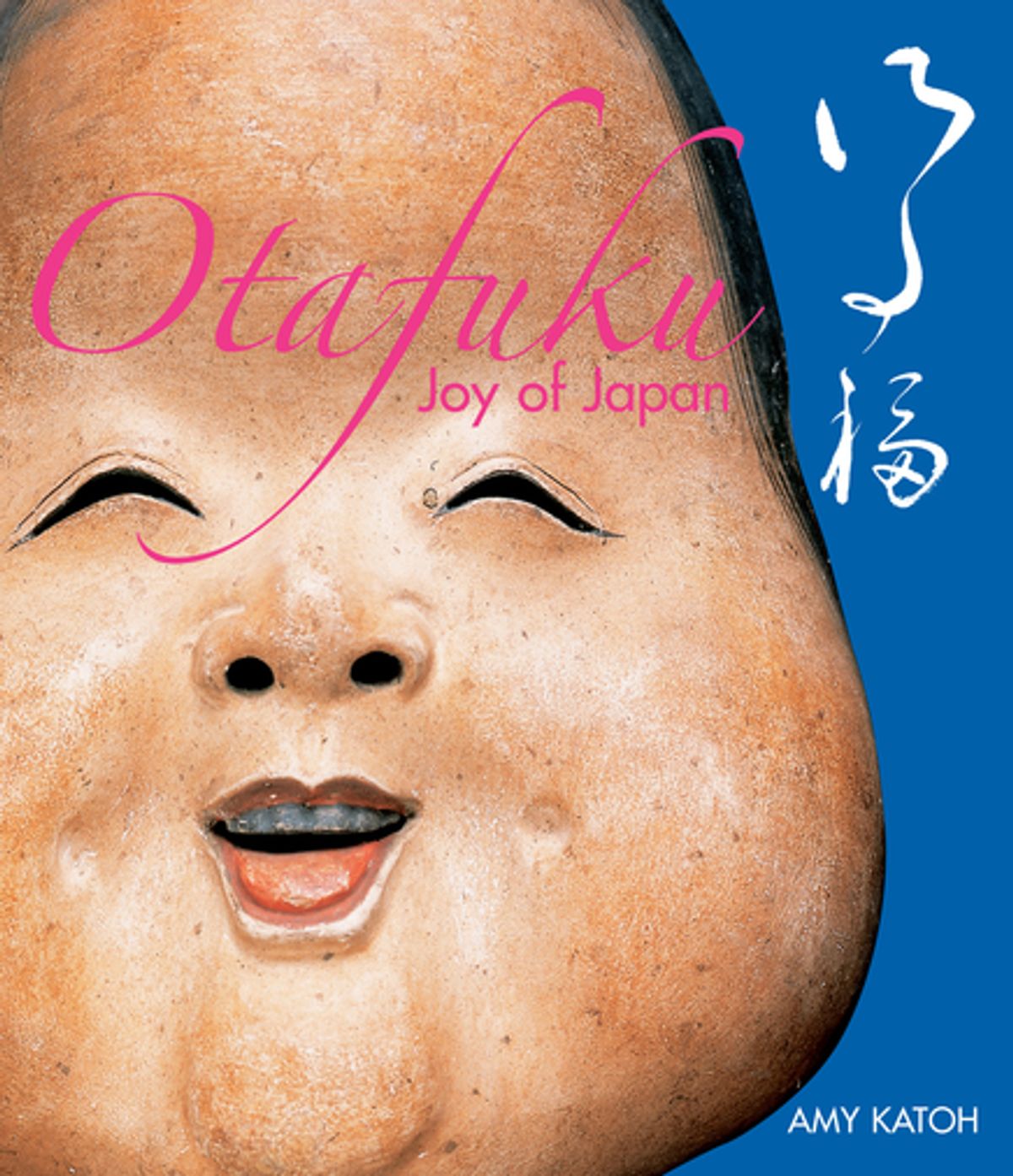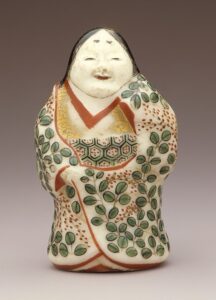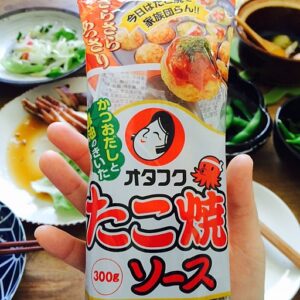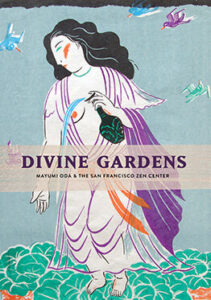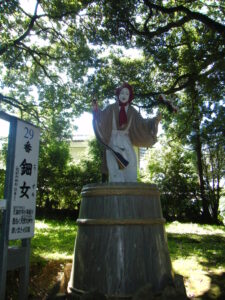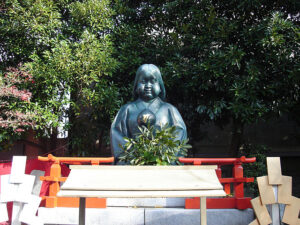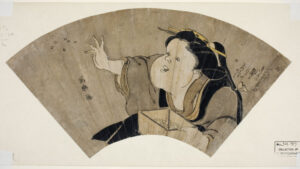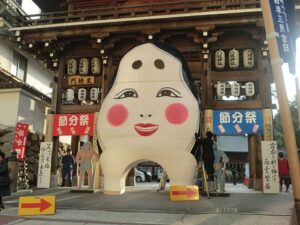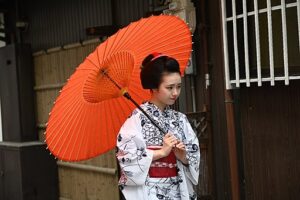Who is this character with the chubby cheeks, tiny red mouth, and impish smile? You see her everywhere in Japan. Antiques, fine art, everyday cloth and tableware celebrate her. She’s commonly called Otafuku or Okame. What’s her story?
To find out about this happy figure, I turned to Otafuku: Joy of Japan (2005). Today’s post introduces this book, learning something about Otafuku’s many meanings, forms, and stories. Wrapping up, we see how maiko join Otafuku in Setsubun festivities.
Otafuku: Joy of Japan by Amy Sylvester Katoh
If you’re looking for something fun, visual, and upbeat to read, this is the book for you.
Here, Amy Sylvester Katoh, a true Okame fan for over 25 years, offers personal stories and legends. She uses the terms Okame and Otafuku interchangeably. A bilingual book, Otafuku has short essays in English followed by Japanese translations. What Japanese might call kansō — essays about one’s thoughts and impressions. Otafuku inspires Katoh’s pursuit of play and pleasure in everyday life.
A collector, Katoh shares many color photos of her varied Okame treasures. We find delightful toys, textiles, teapots, comic stage masks, and even Okame sushi. Otafuku is a brand name for food products, too.
This variety of images illustrates the “100 Faces of Otafuku.” Her big cheeks, tiny red mouth, and high forehead stand out as trademarks. Katoh also shows Okame’s multiple “shapes and attitudes — charming, coquettish, vulgar, cutesy, and downright ugly” (49).
Issa’s Poetry Fits Otafuku
Grandmama’s
out drinking–
ah! the moonlight!
–Issa
Haiku enlivens Otafuku. Katoh quotes charming poems by the wandering poet-priest Kobayashi Issa. Above, he paints the scene of an eldery woman enjoying the moonlight and her rice wine. It reminds me of this laughing Okame, chuckling at a rather suggestive mushroom’s shadow (below).
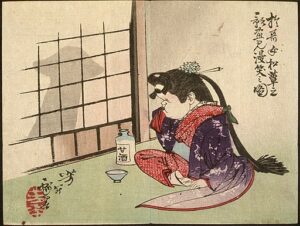
Okame Laughing at the Shadow of a Mushroom, 1882. Artist Yoshitoshi (1839-1892). LA County Museum of Art. Wikimedia.
Katoh also refers to the lighthearted Okame-themed art of Zen priest Hakuin. Her friend painter Mayumi Oda introduced Hakuin to Katoh. Oda’s plump goddesses exude the joy of Otafuku, too. But their divinity seems freer, more associated with nature and the great outdoors, and less domestic than Okame.
A Goddess of Everyday Life
Although she concentrates on Okame, Katoh aims her book as a catalyst to a broader message about the everyday. She writes, “This book is about the little things that make our days flow” (38). It’s also about “celebrating the everyday ceremonies of life” (34). Imperfection is okay, and even desirable.
For Katoh, Okame characters invoke benevolence and creativity. She describes her as “fun and playful and open,” a soothing presence that invites one to pause to share tea and chat. Finding Okame “warm, cozy, loving, accepting,” Katoh takes heart from her “joyful attitude toward life” (75-76).
Traditional Kyoto gives English glosses for her names. “Otafuku literally means “Much Good Fortune”, and Okame means “Tortoise”, also a lucky symbol for long life.”
But where did this character originate? There are multiple stories. Here are two.
An Ancient Fable of Origin
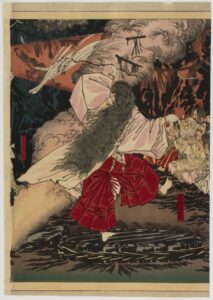
Ame no Uzume no Mikoto Dancing to Lure Amaterasu Ōmikami from her Cave, 1879. Artist Yoshitoshi.
Phil. Museum of Art.
Katoh likes to connect the folk image of Otafuku to the ancient Kojiki myth of Japan’s origins and the story of dancer Ame-no-Uzume. Here’s the story of the mythical performer who saved the day (pun intended).
Crisis occurred when the sun goddess Amaterasu, angry at her brother, secluded herself in a cave. Her retreat plunged heaven and earth into darkness. But when charismatic Uzume danced nearby, eight million gods erupted in rip-roaring laughter. Curious, Amaterasu peeked out at the scene. In that moment, one of the gods pulled her outside the cave. “Thus light and order were returned to the world because of Uzume’s comic dance” (93).
For Katoh, Okame’s character reflects traits of the mythical Uzume. “Uzume’s basic primal strength, her pure and unsullied humor and goodness are all contained in the myth of saving the universe from darkness and chaos with courage and laughter” (104). Katoh sees humor, goodness, and play in Okame figures, too.
A Gruesome Okame Origin Story in Kyoto
But not all Okame stories are happy ones. One myth reveres female sacrifice.
This story comes from Senbon Shakado, also known as Daihōonji. It’s reputedly Kyoto’s oldest Buddhist temple. The temple has an Okame statue (see image above). It also has “hundreds of Okame figures” in its collection “donated by believers” (176-77).
As the temple story goes, Okame prayed to the gods for advice to salvage her carpenter husband’s mistake in building the temple. Her “clever solution” worked. Katoh explains that Okame then gave her life in gratitude to the gods (167). Others say she sacrificed her life to save her husband’s reputation. Perhaps he’d lost face by relying on his wife’s cleverness and plea for divine intervention.
Okame as Good Fortune for New Construction
In honor of Okame, the husband placed her image on the roof beams of the temple. Katoh explains that even today, some carpenters and construction companies in Japan hang an “Okame mask with a circle of three open fans on the roof beams of a new building” (168).
Okame at Setsubun Festivals
Our last post discussed the early February holiday Setsubun. These festivities mark both the last day of winter and the last day of the year. A goddess of happiness, Okame often figures in Setsubun festivals. After all, they are dedicated to banishing evil spirits and welcoming good ones.
In Fukuoka, Kyushu, an immense Okame (see image above) serves as the entrance to Kokura Yasaka Shrine. In Kyoto, the Setsubun festival at Senbon Shakado Temple starts with maiko from Kamishichiken dancing. A comic kyōgen play featuring Okame follows. The event ends with the mamemaki ritual of tossing soybeans to banish evil spirits (Sharing Kyoto).
Fun Spending Time with Otafuku: Joy of Japan
After reading Katoh’s lively book, I have even more curiosity about Otafuku/Okame. I’ll be on the lookout for her, too. Otafuku: Joy of Japan offers a positive look at the imperfections and possibilities in every day life.
Next post: The Maiko’s Paper Umbrella
No vinyl umbrellas for the maiko! Our next post looks into her traditional paper and bamboo umbrella (wagasa). This topic takes us into romantically rainy (and comic) moments in Japanese art, folklore, and maiko fiction.
FEATURED IMAGE: Book cover. Otafuku: Joy of Japan. Amy Sylvester Katoh. Tuttle Publishing, 2005.
REFERENCES
Here’s an interview with Amy Sylvester Katoh about the process of writing Otafuku:
Shulenberger, Damon. “Otafuku Encounters.” SWET: Society of Writers, Editors, and Translators. March 31, 2006. https://swet.jp/articles/article/otafuku_encounters/_C28
Here’s the website for Katoh’s store Blue & White:
https://www.blueandwhitejapan.com/
“Setsubun Festival.” Sharing Kyoto. Aug. 18, 2017.
https://sharing-kyoto.com/event_Setsubun-e-senbon-shakado/story
“Otafuku/Okame.” Short article and informative video at site, Traditional Kyoto: https://traditionalkyoto.com/culture/figures/otafuku/
Interestingly, this site explains that “Japanese scholars theorize that long ago, when the first Okame images were created, they may have represented an idealized form of feminine beauty.”
Jan Bardsley, “Otafuku: Goddess of Everyday Life,” janbardsley.web.unc.edu, February 7, 2022.
